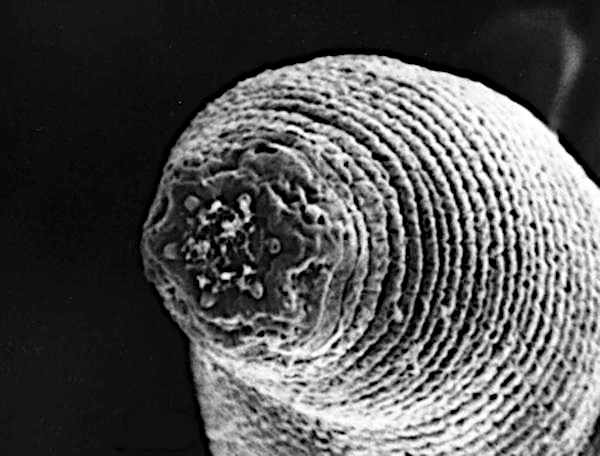
Discovered more than 3.5 km deep in the Beatrix gold mine (South Africa), Halicephalobus mephisto is a multicellular nematode capable of living in extreme environments. A temperature of 37°C, pressure exceeding 300 bars, salinity, and the absence of oxygen make it a unique case in the animal world. This worm is a rare example of extremophile adaptation within the animal eukaryotic kingdom.
Mephisto lives in very ancient pockets of water (dated up to 3 million years) trapped in fractures of metamorphic rocks. The environment is anoxic, saturated with hydrogen, methane, and reduced sulfides. The pH is moderately acidic (between 5 and 6), and the electrical conductivity reveals the high mineralization of the fluid.
Unlike extremophile bacteria or archaea that dominate these environments, Mephisto is a multicellular eukaryote. Its segmented body, asexual reproduction (parthenogenesis), and anaerobic metabolism make it unique. It likely feeds on microbial films (biofilms) composed of chemolithotrophic bacteria.
The discovery of Mephisto broadens the possibilities for life beyond Earth. It suggests that multicellular forms could subsist in extreme underground environments on Mars, Europa, or Enceladus. Mephisto is thus evidence that life can exist deep beneath an inhospitable surface.
| Parameter | Value | Known Limit | Source |
|---|---|---|---|
| Depth | 3.6 km | Record for a multicellular animal | Borgonie et al., 2011 |
| Temperature | 37 °C | Upper limit for nematodes | Nature 474, 79–82 (2011) |
| Oxygen | Absent | Strictly anaerobic life | Onstott et al., 2006 |
| Salinity | High | Conductivity > 2 mS/cm | Underground mine fluid study |
| Carbon Source | Microbial biofilms | No photosynthesis | Indirect observations |
| Food Source | Chemolithotrophic bacteria | Via ingestion of biofilms | Borgonie et al., 2011 |
| Size | 0.5 mm, or 500 µm | Visible under microscope, typical nematode | Morphological analysis of specimens (Borgonie, 2011) |
Sources: Borgonie et al., Nature, 2011 • Onstott et al., Deep Subsurface Biology.
Mephisto demonstrates that life can persist and evolve in extreme conditions long considered uninhabitable for multicellular organisms. This discovery revolutionizes our understanding of the limits of Earth's biosphere and fuels scientific speculation about life in extraterrestrial underground environments.